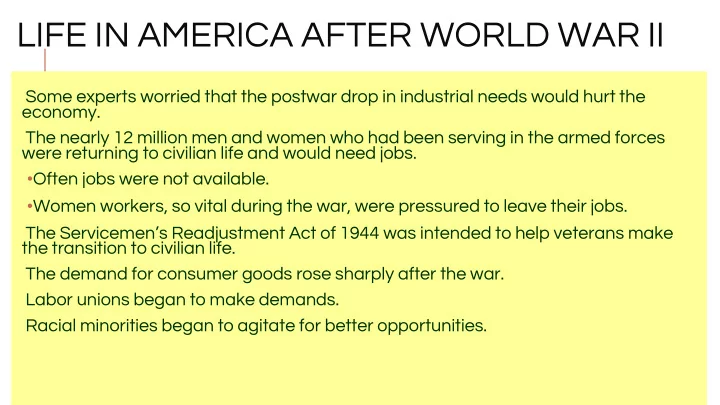

LIFE IN AMERICA AFTER WORLD WAR II Some experts worried that the postwar drop in industrial needs would hurt the economy. The nearly 12 million men and women who had been serving in the armed forces were returning to civilian life and would need jobs. • Often jobs were not available. • Women workers, so vital during the war, were pressured to leave their jobs. The Servicemen’s Readjustment Act of 1944 was intended to help veterans make the transition to civilian life. The demand for consumer goods rose sharply after the war. Labor unions began to make demands. Racial minorities began to agitate for better opportunities.
LIFE IN AMERICA AFTER WORLD WAR II • The Servicemen’s Readjustment Act of 1944 was better known as the GI Bill . • The bill helped veterans transition to civilian life. The GI Bill – Provided money for vets to attend college or receive advanced job training – Helped arrange for home, farm, or business loans – Provided help in finding work as well as a year’s worth of unemployment benefits • Demand for consumer goods rose sharply. Increased • Returning vets built houses, which increased the demand for Demand furniture and appliances. • A baby boom began as Americans began having families.
What were three THE IMPACT OF THE major impact areas of BABY BOOMERS the Baby Boom Generation?
Before King, there was Randolph Truman desegregates the military 10:03 – 12:15 WWII Generation Civil Rights - Jackie Robinson What have sports meant to cultural change in our nation? What does baseball look like today?
1950s Civil Rights Full Examination of the Till Case
The Rev. Ralph Abernathy, left, Rev. Dr. Martin Luther King, Jr., center, and Bayard Rustin, leaders in the racial bus boycott in Montgomery, Ala., leave the Montgomery County Courthouse on Feb. 24, 1956.
Martin Luther King, 27, and his wife, Coretta Scott King, emerge 23 March 1956 from Montgomery Court House, following his trial on charges of conspiring to boycott segregated city buses.
http://www.naacpldf.org/brow n-at-60-the-doll-test The plaintiffs of Brown v. Board and their children (1/1/1953)(Carl Iwasaki/LIFE magazine/Getty) Front row: Vicki Henderson, Donald Henderson, Linda Brown, James Emanuel, Nancy Todd, Katherine Carper Back row: Zelma Henderson, Oliver Brown, Sadie Emanuel, Lucinda Todd, Lena Carper
Before Brown, There Was Mendez Supreme Court Proceedings of Brown v Board To separate [the Negro children] from others of similar age and qualifications solely because of their race generates a feeling of inferiority as to their status in the community that may affect their hearts and minds in a way unlikely ever to be undone. The effect of this separation on their educational opportunities was well stated by a finding in the Kansas case by a court which nevertheless felt compelled to rule against the Negro plaintiffs: Segregation of white and colored children in public schools has a detrimental effect upon the colored children....Chief Justice Earl Warren on the Supreme Court’s unanimous decision
This unwarranted exercise of power by the court, contrary to the Constitution, is creating chaos and confusion in the states principally affected. It is destroying the amicable relations between the white and Negro races that have been created through ninety years of patient effort by the good people of both races. It has planted hatred and suspicion where there has been heretofore friendship and understanding. Without regard to the consent of the governed, outside agitators are threatening immediate and revolutionary changes in our public school systems. If done, this is certain to destroy the system of public education in some of the states.
The Brown decision declared the system of legal segregation unconstitutional. But the Court ordered only that the states end segregation with “all deliberate speed.” This vagueness about how to enforce the ruling gave segregationists the opportunity to organize resistance. Blackish Takes on Desegregation in Education Although many whites welcomed the Brown decision, a large number considered it an assault on their way of life. Segregationists played on the fears and prejudices of their communities and launched a militant campaign of defiance and resistance.
1950s Civil Rights - The Rage Within Another Way to Look at Little Rock
Recommend
More recommend